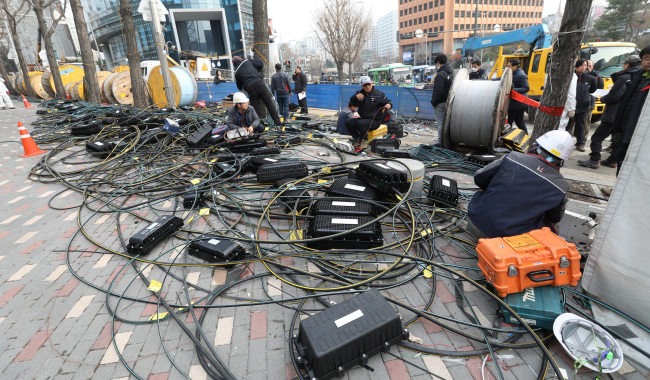A woman died of a heart attack Sunday, when her husband could not call for an ambulance on time due to an abrupt network blackout in Seoul caused by a fire.
The damage that hit one regional branch of the nation’s telecom giant, KT Corp., shook the hyper-connected country -- not only paralyzing the basic communication tools of residents in the area, but also interfering with essential social infrastructure and emergency services.
The damage that hit one regional branch of the nation’s telecom giant, KT Corp., shook the hyper-connected country -- not only paralyzing the basic communication tools of residents in the area, but also interfering with essential social infrastructure and emergency services.

When the 76-year-old woman in Mapo, western Seoul, complained of chest pains at around 5 a.m. Sunday, her husband tried to call an ambulance. But the whole family subscribed to KT, and emergency calls wouldn’t go through. He ran outside to ask a stranger for help -- but by the time the ambulance arrived, his wife had already died, according to the authorities.
“I tried all I could, but I could not save her. If I could have made the call properly, and had the rescue team come only five minutes earlier, we could have saved her,” the husband told a local media outlet.
Landline, mobile and internet networks in areas managed by the Ahyeon branch of KT Corp. in Seoul suffered a blackout over the weekend after the building caught fire at around 11:10 a.m. Saturday. Services remained unavailable or spotty in western Seoul and parts of Goyang City in Gyeonggi Province until late Sunday.
“(The death caused by the incident) clearly shows how a network failure can threaten the safety of the people and cause inconvenience. It was the worst example of a man-made calamity,” Rep. Noh Woong-rae of the Democratic Party of Korea said in a local radio interview Tuesday.
There were no direct human casualties from the fire, but 79 meters of underground cable burned, causing an estimated 8 billion won ($7 million) in property damage. And the consequences of the network failure were dire, as the Mapo incident shows.
On Twitter, a nurse who works in one of the hospitals located in the affected Seodaemun district, described the urgent situation she faced at work when the network failure occurred.
“Our medical staff use KT services for their work phones. Because it did not work, doctors could not call each other in emergencies, and we had to use the internal broadcasting system instead. I thought somebody might die from this situation,” the nurse who refused to be named, wrote on her Twitter account.
“The oxygen saturation rate was falling to the 60s and I could not call a doctor. I could not leave the patient to get help myself. So another person ran all around the hospital for an available doctor. (As I watched) the patient became bluer, and I thought I wanted to die.”
For a long time, Korea has boasted of its status as the world’s most wired country. But it was only after the fire that the country was made aware that it needs backup measures to deal with failures in information technology.
On-site inspections revealed that there was only one fire extinguisher installed in the underground floor of the KT branch building, where 168,000 telephone wires and 220 unit sets of optical fiber cables were housed.
Experts stressed that the government needs to be aware of the implications of technological development and ensure that appropriate emergency-response systems are in place.
“The advance in technology always comes with weaknesses in safety and security. Once physical safety measures and information security collapses, daily lives can be paralyzed,” said Nahm Kee-bom, an urban sociology professor at University of Seoul.
“The effect of an accident in the IT industry on society is much greater than it was 20 to 30 years ago,” said Ahn Jong-joo, the chief of Social Safety Communications Center under the Korea Social Policy Institute.
“Information technology services can be considered public (utilities), like gas and electricity. So there should be some kind of regulations to encourage or mandate the industry to spend a certain amount of money on safety measures.”
By Jo He-rim (herim@heraldcorp.com)










![[Hello India] Hyundai Motor vows to boost 'clean mobility' in India](http://res.heraldm.com/phpwas/restmb_idxmake.php?idx=644&simg=/content/image/2024/04/25/20240425050672_0.jpg&u=)









